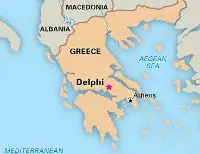Delphi: Center of Ancient Greek World
The city-state of Delphi was regarded as the center of Ancient Greece, in more ways than one. 
Delphi was regarded as the geographical center of the Ancient Greek world. The legendary origin story of the city-state has it that Zeus, the chief god, wanted to find the center of all things and so sent out two eagles, one flying westward from the eastern end of the known world and the other flying eastward from the western world. The idea was that the place the eagles met would be the center, and where those eagles met was founded Delphi. It was called the omphalos, or navel of the world. The place was marked by a stone of the same name. Gaia, the mother goddess, was also a focus of worship in Delphi. As the story went, it was to the center of Gaia that Zeus sent the eagles. Delphi is also said to have taken its name from one similar to dolphin. This is another nod to Apollo, who was said to have traveled to Delphi from Crete aboard a dolphin. Delphi, with its idyllic setting among the slopes of Mount Parnassus, was home to the famous Pythian Oracle. People from across the ancient world made a habit of traveling to Delphi to consult the Oracle before making key decisions. The Oracle's practices and pronouncements were shrouded in mystery. The patron god of Delphi was Apollo. The god of many things, he was also known as Pythian Apollo because of a legend that said that when he was young, he had killed Python, a serpent, on the very spot where the Oracle was. Python (also sometimes written Pytho) protected the omphalos. The Oracle was known as the Pythian and the sibyl and always an older woman. The Pythia was commonly in the inner sanctum, alone. She would sit on a tripod seat placed on top of a fissure out of which came intoxicating vapors. The Pythia would inhale the vapors and then go into a trance, inside of which she would speak strange words. Other priestesses would translate the Pythia's utterances into prophecies, which were often enigmatic. The process of consulting the Oracle (and getting a response) was an involved and time-consuming one; the Oracle was also was not "in session" every day of the year. Visitors would be required to ply the Oracle and the priestesses with gifts or offerings to the gods as well. The Pythian tradition also featured in one of the Panhellenic Games; the every-four-years contest held in Delphi was the Pythian Games, a celebration of Apollo's victory over Python. These Games began as a musical contest; athletic events were added later. Winners of events at the Pythian Games received, among other things, a crown made of laurel (bay tree), which Apollo considered sacred. Near the Oracle was the Castalian Spring, where both the Oracle and her visitors stopped to wash themselves. Some accounts of Apollo's victory over Python say that the monster was guarding the spring. Delphi had a large Temple of Apollo, inside which burned an eternal flame. Because of its position as host of the Pythian Games, the city-state had more than the usual trappings of a Greek and later Roman settlement. Among those were a gymnasium, a hippodrome, a stadium, several temples, a theatre, and a few treasuries. The theatre could accommodate 4,500 spectators. Delphi flourished and waned for many years, attacked by Persians and Gauls and ruled eventually by Macedon and Rome. A leader named Philomelos led a tribe of Phocians in an attack in 356 B.C. that resulted in the sacking of Delphi. Another sacking occurred in 86 B.C., at the hands of the Roman general Sulla. Delphi was the victim of a violent raid in 83 B.C., during which the temple was burned and the eternal flame stolen; an earthquake later that same year further damaged the temple. Roman troops under the emperor Nero sacked the city-state in A.D. 66. The Roman emperor Hadrian, ruling more than a century later, took a liking to Delphi and visited the Oracle more than once; the city-states flourished anew as a result. The last gasp of the Oracle occurred in 390, when Roman troops under Emperor Theodosius I destroyed the temple and its statues and art works, under the guise of promoting Christianity at the expense of other religions. Delphi was also known for its many statues, particularly of athletes. One of the most famous is the Charioteer.
|
|
Social Studies for Kids
copyright 2002–2025
David White




